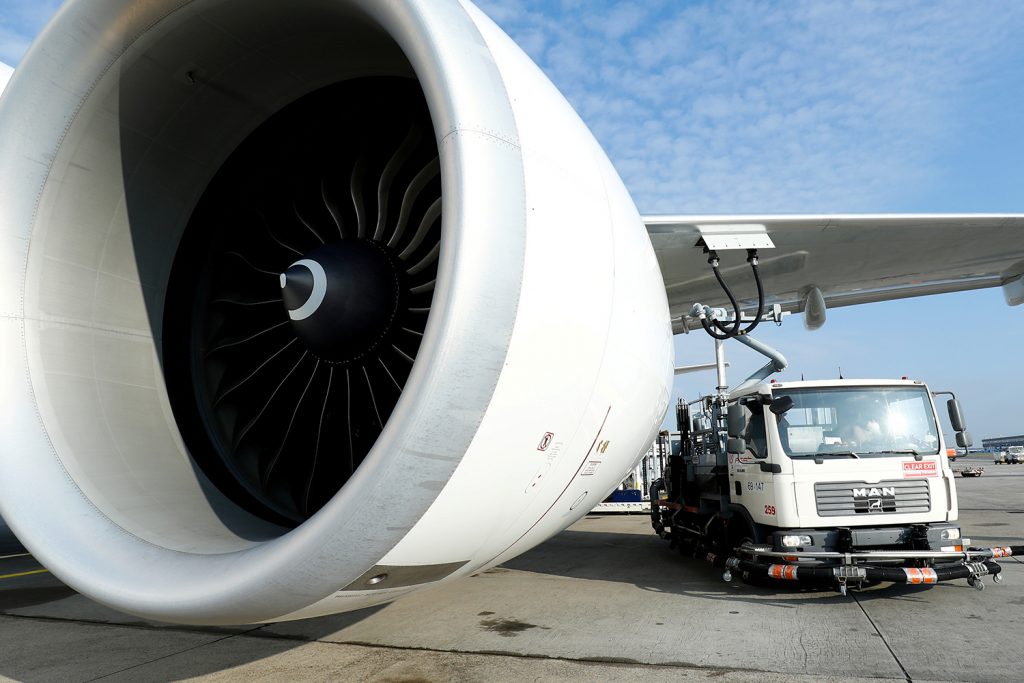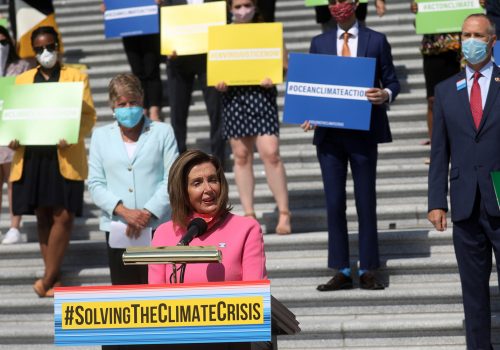The COVID-19 pandemic has generated “the most severe crisis for aviation ever,” said Marc Hamy, vice president of corporate affairs, sustainability, and environment at Airbus. But there’s another crisis on the horizon for the aviation industry: “increasing pressure coming from climate change. So we absolutely need to recover from this crisis in aviation, and at the same time we’ll have to manage the most important transition in the history of our sector: decarbonized aviation.” Hamy added.
Hamy was speaking at an Atlantic Council 2021 Global Energy Forum event moderated by Thomas Hicks, founding principal and managing director of Mabus Group.
Scott Kirby, CEO of United Airlines, noted that “we never contemplated anything like this [pandemic], even in our worst-case planning scenarios.” The pandemic has made sustainability “more important than ever,” he argued, because after the global spread of COVID-19 “there is no way that anyone can tell you with a straight face that we are not part of a global community and everything that happens everywhere in the world is connected to everywhere else.”
“The signals are out there that as we come out of this, we’re going to have to be more conscious of sustainability,” agreed Jennifer Holmgren, CEO of LanzaTech. Jeremy Baines, president of sustainable aviation fuel-producer Neste US, reflected that “once we get out of this [pandemic], I want to start flying again… but there’s also an awareness that we want to do it more sustainably than in the past.”
Here are the key takeaways from their discussion on decarbonizing aviation.
Decarbonizing solutions abound, but there’s no magic bullet
- What the near-future holds: Hamy said he believes “carbon-less aviation is possible and we can achieve it in this lifetime.” But Baines added that he doesn’t think “there is a magic bullet to this; there’s no one single solution that is going to make flying more sustainable.”
- Step one: modernize aviation: Not every solution will require groundbreaking new technologies or fuels, Kirby clarified: “We estimate that we can improve efficiency by fifteen percent by just using, essentially, GPS technology to fly instead of flying the highways in the sky that we fly today.” He also highlighted carbon sequestration as one of many solutions: “I’m convinced there’s no way we’re going to decarbonize the planet without that,” he said.
- What airlines can do: But airlines are also investing in futuristic innovations and commitments to decarbonize their flights. For example, Airbus aims to put a zero-emission aircraft into service by 2035 that runs on hydrogen. Hamy believes hydrogen could constitute “a very large part of the energy production of transport in the near future and I think we cannot miss this opportunity,” and that hydrogen may one day replace oil. Meanwhile, United Airlines has committed to reducing greenhouse-gas emissions by 100 percent by 2050 and has invested in 1PointFive, a project—led by partners Oxy Low Carbon Ventures of Occidental Petroleum Corporation and Rusheen Capital Management—that aims to capture carbon-dioxide emissions from the air. By investing in the project, Kirby hopes to lower the cost of carbon capture across the board: “I recognize it’s not economical today… You’ve got to come down exponentially on those cost curves.”
- Work with what we have today: Baines fears that technological innovations like hydrogen-powered planes and low-cost carbon capture may still be “a while off,” but noted that fuel solutions are already reducing emissions by about 80 percent today and the fuel “works without changing any infrastructure.” Holmgren agreed, adding that “sustainable aviation fuel is a key way to bend the [increasing carbon emission] curve and a key way to do something in the aviation industry now.”
Watch the full event
Sustainable aviation fuel, explained
- From gas to fuel: Holmgren explained that to make sustainable aviation fuel, LanzaTech uses and converts gases. “So it can be industrial waste gases, carbon monoxide, hydrogen, carbon dioxide, gasified municipal solid waste, gasified biomass, [and] we can also take direct air capture.” When asked whether the company predicts encountering an undersupply of feedstock once the production of sustainable aviation fuel ramps up, Holmgren replied that “there is plenty of feedstock” and “once we start getting into solid waste and mixed waste, there’s nothing stopping you.”
- A flexible supply can meet demand: Baines agreed, noting that “you would really start seeing the demand pick up and the supply would come online to match it.” For example, Neste US has used cooking oil from airports but is “also looking to move into algae… we can also use forestry waste.” Baines added that the conditions for feedstock supply are looking even better in the future, as passenger vehicles are beginning to go electric, leaving sustainable fuels behind. “That will free up feedstocks for the harder industries, like the aviation sector,” he explained.
- An impact beyond the environment: Asked whether aircraft perform as efficiently on sustainable aviation fuel as they do on fossil fuels, Hamy explained that currently, the fuel is only approved for 50 percent blends or less, but he’s detected no issues. “Now, we have to explore if we can go up to 100 percent; we think it will be possible,” said Hamy. Holmgren added that, although it may not be noticeably more efficient than fossil fuels, sustainable aviation fuel is better for people as well. “These fuels don’t have sulfur, particulates are significantly less,” she explained, which means “a big reduction in contrails. These things are really important if you live near an airport… And so they augment the social justice issue.”
It’s not just airlines; the government can help too
- Incentivize innovation: Efforts to decarbonize require “partnership and leadership” across industry and government, said Holmgren, noting that she found it “extremely important to have [government] incentives that enable the production of sustainable aviation fuel.” She added that government incentives can also help create “a distributed approach to the production of aviation fuels… [to] build the first [plant], build the second one, build the fourth one, and then this will take off.”
- Support the farmers behind fuel: Holmgren also suggested that fuel producers and farmers who produce ethanol for aviation fuel harness the opportunity to make their processing more sustainable—and get government credits for making sustainable choices such as using better agricultural practices and lower-carbon fertilizer. LanzaTech recently established the company LanzaJet, which aims to produce ten million gallons of sustainable aviation fuel from ethanol each year. “I see a partnership between the producers and the farmers, creating a lower [carbon-intensity] product by figuring out how to make the feedstock production more sustainable.”
- Raise the cost of climate impact: Kirby said “we’re not going to solve this unless we put a price on carbon… and [get] support for sequestration and other credit mechanisms. Government support for those [is crucial] so that you can build the economies of scale and drive the prices down.”
Katherine Walla is the assistant director of editorial at the Atlantic Council.
Further reading
Image: An aircraft, operated with sustainable aviation fuel (SAF), is refueled at Frankfurt airport, Germany, November 27, 2020. REUTERS/Ralph Orlowski



